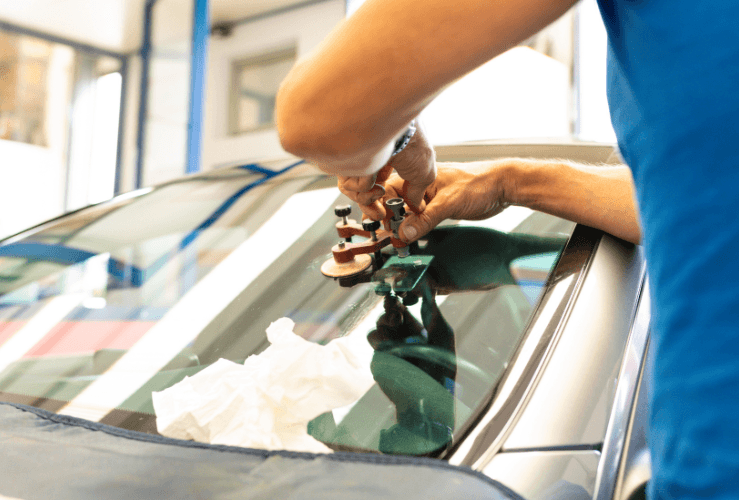If you notice your windscreen has been chipped, it's important to get it fixed promptly. If you don't act, a larger crack could develop, which could mean you have to replace the entire windscreen.
You could therefore save a lot of money by getting any chips repaired as soon as you spot them.
Additionally, by law you must be able to drive without your view of the road being obscured. So if a chip or crack has appeared in front of the driver's position, you should not drive your vehicle until a repair is carried out.

(3) of Regulation 30 of the Road Vehicles (Construction and Use) Regulations 1986 (SI 1986 No. 1078 as amended) requires that:
"All glass or other transparent material fitted to a motor vehicle shall be maintained in such condition that it does not obscure the vision of the driver while the vehicle is being driven on a road."
What about larger windscreen cracks?
If your windscreen has a larger crack in it, the structural integrity of your glass may be compromised, in which case a full replacement may be needed.
A commonly available windscreen rock chip repair kit will not be suitable for larger cracks.
DIY windscreen filler repair
Many windscreen filler repair kits are available online and in automotive stores.
Simple DIY windscreen ding repair kits can cost as little as £10, while more sophisticated kits can cost more than £100.
Note: If you are unsure of what is required to fix any problems, please consult a professional.
How do windscreen filler repair kits work?
Most filler repair kits work in a similar way. You:
- Remove any fragments and debris from the damaged area.
- Clean the area with alcohol or a similar solution.
- Position the provided 'stencil' or device to hold the resin in place.
- Apply the liquid resin.
- Use the supplied syringe to help set the resin.
- Apply the provided curing strip.
- Allow the resin to cure in daylight or using a UV torch (the latter is not normally provided with the kit).
Windscreen chip: before and after
If you have followed the directions properly, the damage will not be visible after repair - or will only be barely visible on close inspection.
Note that with so many kits available, application processes will vary. Ensure you carefully read the supplied instructions before you begin.

Paying a company to fix your windscreen
Many glass repair companies operate across the UK. They all use the 'resin/cure' approach described above, albeit with more sophisticated equipment.
The big advantage here is that you don't have to do it yourself. Professional windscreen repair firms should also be able to do the job quickly - in about 30 minutes.
The downside is the price. It could cost in excess of £200 for chipped glass, and considerably more for a full windscreen replacement.
Will my car insurance pay for windscreen repairs?
Whether or not your insurer will cover the cost of any windscreen repair (small windscreen chip or full replacement) will depend on the terms and conditions of your policy. Even if your policy does cover you, you will almost certainly have to pay an excess.
UK windscreen repair companies often have close working relationships with car insurers, which means they can handle the insurance claim on your behalf.
If your car insurance does not include glass cover, you'll have to pay for any repairs yourself.
DIY repairs: Is it worth repairing my own windscreen?
If your car insurance does not include glass cover, and the damage is minor (e.g. a small windscreen chip), it could be worth buying a do-it-yourself chip/crack windscreen repair kit.
The big caveat here is that if you do not effect the repair sufficiently, a professional windscreen firm may not be able to rectify the issue.
While it is possible to effect repair to chips in different parts of a windscreen, you cannot attempt two repairs on the same area of damage.
If your DIY repair does not go to plan, you may well need to have your windscreen replaced.
Common causes of chipped windscreens:
Flying Debris: Small stones, rocks, or gravel thrown up by passing vehicles.
Road Conditions: Driving on rough ground or gravel.
Temperature Changes: Sudden changes in temperature can weaken the glass, making it more susceptible to chipping, e.g. - extreme cold followed by rapid heating from defrosters can stress glass.
Other impacts: Impacts from tree branches and hailstones.
Stress Fractures: Existing stress points in the glass, often caused by manufacturing imperfections, can develop into chips over time due to the pressure of driving or temperature changes.
Age and Wear: Older windscreens may be more prone to chipping due to wear and tear over time, together with exposure to environmental elements.
As mentioned, it's important to get any windscreen damage repaired as soon as you can.
For more information, read our blog: Damaged Windscreen: Here's Why You Should Fix It Promptly




